

Edition 1 (1975) Oblique Strategies. Origin and history[edit] The entire story of Oblique Strategies, with the content of all the cards, exhaustive history and commentary, is documented in a website widely acknowledged as the authoritative source, put together by musician and educator Gregory Alan Taylor.[4] The text of Schmidt's "The Thoughts Behind the Thoughts" was published by Mindmade Books in 2012.
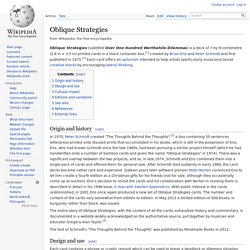
Design and use[edit] Each card contains a phrase or cryptic remark which can be used to break a deadlock or dilemma situation. Some are specific to music composition; others are more general. How to find true friends (and love) in 45 minutes. David Rowan Editor of Wired magazine This article was featured in Times Magazine, 5 November.
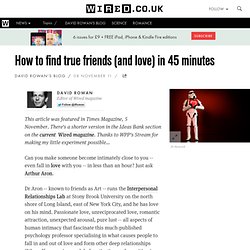
There's a shorter version in the Ideas Bank section on the current Wired magazine. Where do ideas come from? The creative spark. SMO_Periodic_Table.png 2,304×1,584 pixels. Neil deGrasse Tyson on Why We're Wired for Science and How Originality Differs in Science and Art. The Art of Chance-Opportunism in Creativity and Scientific Discovery: A 1957 Guide.
By Maria Popova.
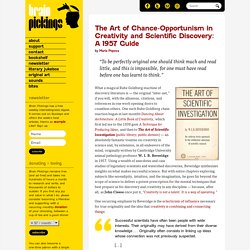
The Role of Intuition and Imagination in Scientific Discovery and Creativity: A 1957 Guide. By Maria Popova “Those who do not know the torment of the unknown cannot have the joy of discovery.”
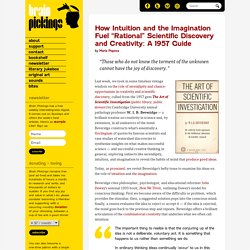
Last week, we took in some timeless vintage wisdom on the role of serendipity and chance-opportunism in creativity and scientific discovery, culled from the 1957 gem The Art of Scientific Investigation (public library; public domain) by Cambridge University animal pathology professor W. I. B. Five Effortless Postures that Foster Creative Thinking. Literally sitting outside a box, rather than in it, makes you more creative, according to new psychological research.
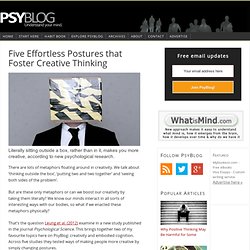
There are lots of metaphors floating around in creativity. We talk about ‘thinking outside the box’, ‘putting two and two together’ and ‘seeing both sides of the problem’. But are these only metaphors or can we boost our creativity by taking them literally? We know our minds interact in all sorts of interesting ways with our bodies, so what if we enacted these metaphors physically? That’s the question Leung et al. (2012) examine in a new study published in the journal Psychological Science. 1. Creative ideas are often arrived at by bringing together two apparently unrelated thoughts.
So, what if while trying to solve a problem you physically hold up one hand followed by the other? Leung et al. had participants doing this and found that those who gestured with both hands came up with more novel ideas than those who gestured with just one hand. Studio Inc. - Blog - #TEDMEDLive. Over 1,200 delegates gathered at TEDMED 2012 from all around the globe and virtually every profession from the Director of the NIH to the world’s foremost big wave surfer.
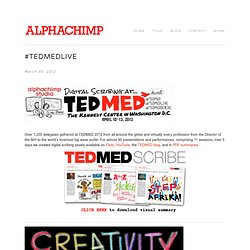
For almost 90 presentations and performances, comprising 11 sessions, over 3 days we created digital scribing assets available on Flickr, YouTube, the TEDMED blog, and in PDF summaries. ABOVE: musician Chris Price brings down the house playing songs from an album made entirely on an iPhone.In Session 11, our closing speakers emphasize the networked nature of digital medicine: that we are all connected, and we can use this to help each other heal. Leslie Saxon, the Founder of the USC Center for Body Computing, wants social networks for medicine; Ali Ansary is a medical student who wants each cell to have its own IP address; Mark Hyman encourages community healing; and Jay Lombard looks for psychiatric biomarkers.
What counts as impact? - Adventures in Career Development. Allowing Your Creativity to Flourish. “Creativity lies at the heart of the scientific process … true progress requires an act of discovery.”
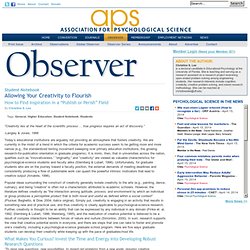
-Langley & Jones, 1988 Today’s educational institutions are arguably not providing an atmosphere that fosters creativity. We are currently in the midst of a trend in which the criteria for academic success seem to be getting more and more narrow (e.g., the standardized testing movement sweeping over primary education institutions, the growing research-for-publication orientation in graduate programs). It is ironic, then, that in universities across the nation, qualities such as “innovativeness,” “originality,” and “creativity” are viewed as valuable characteristics for psychological-science students and faculty alike (Sternberg & Lubart, 1996). Popular ideas surrounding the construct of creativity generally isolate creativity to the arts (e.g., painting, dance, culinary), and being “creative” is often not a characteristic attributed to academic scholars. What Makes You Curious? Eric Mazur on new interactive teaching techniques.
In 1990, after seven years of teaching at Harvard, Eric Mazur, now Balkanski professor of physics and applied physics, was delivering clear, polished lectures and demonstrations and getting high student evaluations for his introductory Physics 11 course, populated mainly by premed and engineering students who were successfully solving complicated problems.
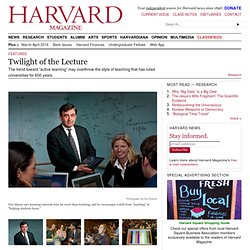
Then he discovered that his success as a teacher “was a complete illusion, a house of cards.” The epiphany came via an article in the American Journal of Physics by Arizona State professor David Hestenes. He had devised a very simple test, couched in everyday language, to check students’ understanding of one of the most fundamental concepts of physics—force—and had administered it to thousands of undergraduates in the southwestern United States. Mazur tried the test on his own students. Some soul-searching followed. Serendipity provided the breakthrough he needed. » The No. 1 Habit of Highly Creative People. “In order to be open to creativity, one must have the capacity for contructive use of solitude.
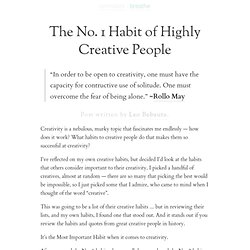
One must overcome the fear of being alone.” ~Rollo May Post written by Leo Babauta. Creativity is a nebulous, murky topic that fascinates me endlessly — how does it work? What habits to creative people do that makes them so successful at creativity? The Rise of the New Groupthink. A 12-Day Plan of Simple Writing Exercises.
It’s the perfect time to restart your engine and get back into writing.

Here, I offer up a 12-day plan of simple writing exercises to help you keep your creative juices flowing without eating up too much of your time. Follow this plan and in less than half a month, you’ll not only be impressed with what you’ve accomplished, but you may also have something worth publishing. The 12-Day Plan of Simple Writing Exercises Day 1: Write 10 potential book titles of books you’d like to write. Day 2: Create a character with personality traits of someone you love, but the physical characteristics of someone you don’t care for. Ambiguous Words. The Idea Swap. Ken Robinson says schools kill creativity. Sir Ken Robinson: Bring on the learning revolution! A Model of The Creative Process.